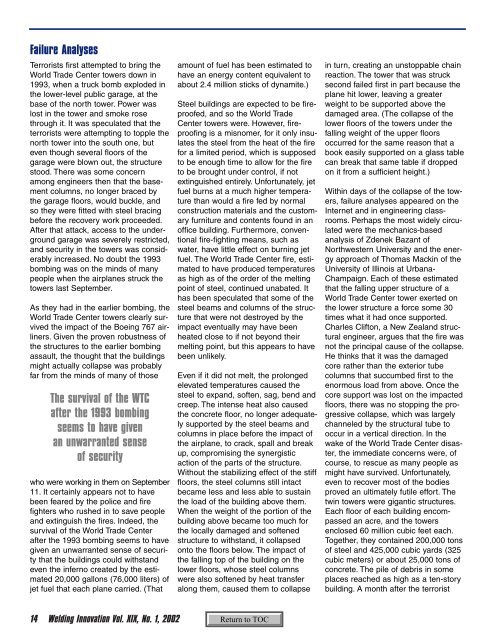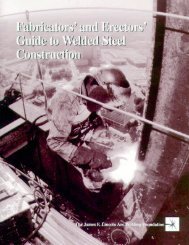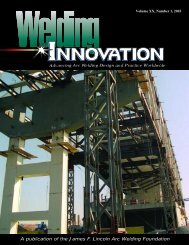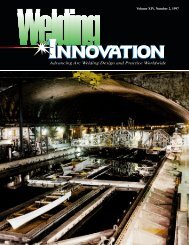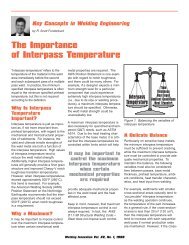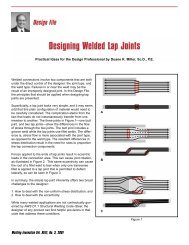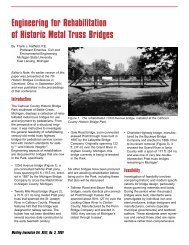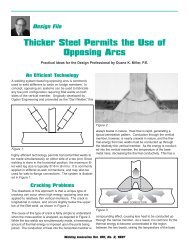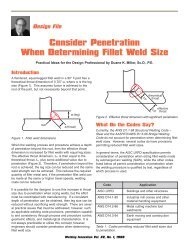A publication of the James F. Lincoln Arc Welding Foundation
A publication of the James F. Lincoln Arc Welding Foundation
A publication of the James F. Lincoln Arc Welding Foundation
Create successful ePaper yourself
Turn your PDF publications into a flip-book with our unique Google optimized e-Paper software.
Failure Analyses<br />
Terrorists first attempted to bring <strong>the</strong><br />
World Trade Center towers down in<br />
1993, when a truck bomb exploded in<br />
<strong>the</strong> lower-level public garage, at <strong>the</strong><br />
base <strong>of</strong> <strong>the</strong> north tower. Power was<br />
lost in <strong>the</strong> tower and smoke rose<br />
through it. It was speculated that <strong>the</strong><br />
terrorists were attempting to topple <strong>the</strong><br />
north tower into <strong>the</strong> south one, but<br />
even though several floors <strong>of</strong> <strong>the</strong><br />
garage were blown out, <strong>the</strong> structure<br />
stood. There was some concern<br />
among engineers <strong>the</strong>n that <strong>the</strong> basement<br />
columns, no longer braced by<br />
<strong>the</strong> garage floors, would buckle, and<br />
so <strong>the</strong>y were fitted with steel bracing<br />
before <strong>the</strong> recovery work proceeded.<br />
After that attack, access to <strong>the</strong> underground<br />
garage was severely restricted,<br />
and security in <strong>the</strong> towers was considerably<br />
increased. No doubt <strong>the</strong> 1993<br />
bombing was on <strong>the</strong> minds <strong>of</strong> many<br />
people when <strong>the</strong> airplanes struck <strong>the</strong><br />
towers last September.<br />
As <strong>the</strong>y had in <strong>the</strong> earlier bombing, <strong>the</strong><br />
World Trade Center towers clearly survived<br />
<strong>the</strong> impact <strong>of</strong> <strong>the</strong> Boeing 767 airliners.<br />
Given <strong>the</strong> proven robustness <strong>of</strong><br />
<strong>the</strong> structures to <strong>the</strong> earlier bombing<br />
assault, <strong>the</strong> thought that <strong>the</strong> buildings<br />
might actually collapse was probably<br />
far from <strong>the</strong> minds <strong>of</strong> many <strong>of</strong> those<br />
The survival <strong>of</strong> <strong>the</strong> WTC<br />
after <strong>the</strong> 1993 bombing<br />
seems to have given<br />
an unwarranted sense<br />
<strong>of</strong> security<br />
who were working in <strong>the</strong>m on September<br />
11. It certainly appears not to have<br />
been feared by <strong>the</strong> police and fire<br />
fighters who rushed in to save people<br />
and extinguish <strong>the</strong> fires. Indeed, <strong>the</strong><br />
survival <strong>of</strong> <strong>the</strong> World Trade Center<br />
after <strong>the</strong> 1993 bombing seems to have<br />
given an unwarranted sense <strong>of</strong> security<br />
that <strong>the</strong> buildings could withstand<br />
even <strong>the</strong> inferno created by <strong>the</strong> estimated<br />
20,000 gallons (76,000 liters) <strong>of</strong><br />
jet fuel that each plane carried. (That<br />
amount <strong>of</strong> fuel has been estimated to<br />
have an energy content equivalent to<br />
about 2.4 million sticks <strong>of</strong> dynamite.)<br />
Steel buildings are expected to be firepro<strong>of</strong>ed,<br />
and so <strong>the</strong> World Trade<br />
Center towers were. However, firepro<strong>of</strong>ing<br />
is a misnomer, for it only insulates<br />
<strong>the</strong> steel from <strong>the</strong> heat <strong>of</strong> <strong>the</strong> fire<br />
for a limited period, which is supposed<br />
to be enough time to allow for <strong>the</strong> fire<br />
to be brought under control, if not<br />
extinguished entirely. Unfortunately, jet<br />
fuel burns at a much higher temperature<br />
than would a fire fed by normal<br />
construction materials and <strong>the</strong> customary<br />
furniture and contents found in an<br />
<strong>of</strong>fice building. Fur<strong>the</strong>rmore, conventional<br />
fire-fighting means, such as<br />
water, have little effect on burning jet<br />
fuel. The World Trade Center fire, estimated<br />
to have produced temperatures<br />
as high as <strong>of</strong> <strong>the</strong> order <strong>of</strong> <strong>the</strong> melting<br />
point <strong>of</strong> steel, continued unabated. It<br />
has been speculated that some <strong>of</strong> <strong>the</strong><br />
steel beams and columns <strong>of</strong> <strong>the</strong> structure<br />
that were not destroyed by <strong>the</strong><br />
impact eventually may have been<br />
heated close to if not beyond <strong>the</strong>ir<br />
melting point, but this appears to have<br />
been unlikely.<br />
Even if it did not melt, <strong>the</strong> prolonged<br />
elevated temperatures caused <strong>the</strong><br />
steel to expand, s<strong>of</strong>ten, sag, bend and<br />
creep. The intense heat also caused<br />
<strong>the</strong> concrete floor, no longer adequately<br />
supported by <strong>the</strong> steel beams and<br />
columns in place before <strong>the</strong> impact <strong>of</strong><br />
<strong>the</strong> airplane, to crack, spall and break<br />
up, compromising <strong>the</strong> synergistic<br />
action <strong>of</strong> <strong>the</strong> parts <strong>of</strong> <strong>the</strong> structure.<br />
Without <strong>the</strong> stabilizing effect <strong>of</strong> <strong>the</strong> stiff<br />
floors, <strong>the</strong> steel columns still intact<br />
became less and less able to sustain<br />
<strong>the</strong> load <strong>of</strong> <strong>the</strong> building above <strong>the</strong>m.<br />
When <strong>the</strong> weight <strong>of</strong> <strong>the</strong> portion <strong>of</strong> <strong>the</strong><br />
building above became too much for<br />
<strong>the</strong> locally damaged and s<strong>of</strong>tened<br />
structure to withstand, it collapsed<br />
onto <strong>the</strong> floors below. The impact <strong>of</strong><br />
<strong>the</strong> falling top <strong>of</strong> <strong>the</strong> building on <strong>the</strong><br />
lower floors, whose steel columns<br />
were also s<strong>of</strong>tened by heat transfer<br />
along <strong>the</strong>m, caused <strong>the</strong>m to collapse<br />
in turn, creating an unstoppable chain<br />
reaction. The tower that was struck<br />
second failed first in part because <strong>the</strong><br />
plane hit lower, leaving a greater<br />
weight to be supported above <strong>the</strong><br />
damaged area. (The collapse <strong>of</strong> <strong>the</strong><br />
lower floors <strong>of</strong> <strong>the</strong> towers under <strong>the</strong><br />
falling weight <strong>of</strong> <strong>the</strong> upper floors<br />
occurred for <strong>the</strong> same reason that a<br />
book easily supported on a glass table<br />
can break that same table if dropped<br />
on it from a sufficient height.)<br />
Within days <strong>of</strong> <strong>the</strong> collapse <strong>of</strong> <strong>the</strong> towers,<br />
failure analyses appeared on <strong>the</strong><br />
Internet and in engineering classrooms.<br />
Perhaps <strong>the</strong> most widely circulated<br />
were <strong>the</strong> mechanics-based<br />
analysis <strong>of</strong> Zdenek Bazant <strong>of</strong><br />
Northwestern University and <strong>the</strong> energy<br />
approach <strong>of</strong> Thomas Mackin <strong>of</strong> <strong>the</strong><br />
University <strong>of</strong> Illinois at Urbana-<br />
Champaign. Each <strong>of</strong> <strong>the</strong>se estimated<br />
that <strong>the</strong> falling upper structure <strong>of</strong> a<br />
World Trade Center tower exerted on<br />
<strong>the</strong> lower structure a force some 30<br />
times what it had once supported.<br />
Charles Clifton, a New Zealand structural<br />
engineer, argues that <strong>the</strong> fire was<br />
not <strong>the</strong> principal cause <strong>of</strong> <strong>the</strong> collapse.<br />
He thinks that it was <strong>the</strong> damaged<br />
core ra<strong>the</strong>r than <strong>the</strong> exterior tube<br />
columns that succumbed first to <strong>the</strong><br />
enormous load from above. Once <strong>the</strong><br />
core support was lost on <strong>the</strong> impacted<br />
floors, <strong>the</strong>re was no stopping <strong>the</strong> progressive<br />
collapse, which was largely<br />
channeled by <strong>the</strong> structural tube to<br />
occur in a vertical direction. In <strong>the</strong><br />
wake <strong>of</strong> <strong>the</strong> World Trade Center disaster,<br />
<strong>the</strong> immediate concerns were, <strong>of</strong><br />
course, to rescue as many people as<br />
might have survived. Unfortunately,<br />
even to recover most <strong>of</strong> <strong>the</strong> bodies<br />
proved an ultimately futile effort. The<br />
twin towers were gigantic structures.<br />
Each floor <strong>of</strong> each building encompassed<br />
an acre, and <strong>the</strong> towers<br />
enclosed 60 million cubic feet each.<br />
Toge<strong>the</strong>r, <strong>the</strong>y contained 200,000 tons<br />
<strong>of</strong> steel and 425,000 cubic yards (325<br />
cubic meters) or about 25,000 tons <strong>of</strong><br />
concrete. The pile <strong>of</strong> debris in some<br />
places reached as high as a ten-story<br />
building. A month after <strong>the</strong> terrorist<br />
14 <strong>Welding</strong> Innovation Vol. XIX, No. 1, 2002


